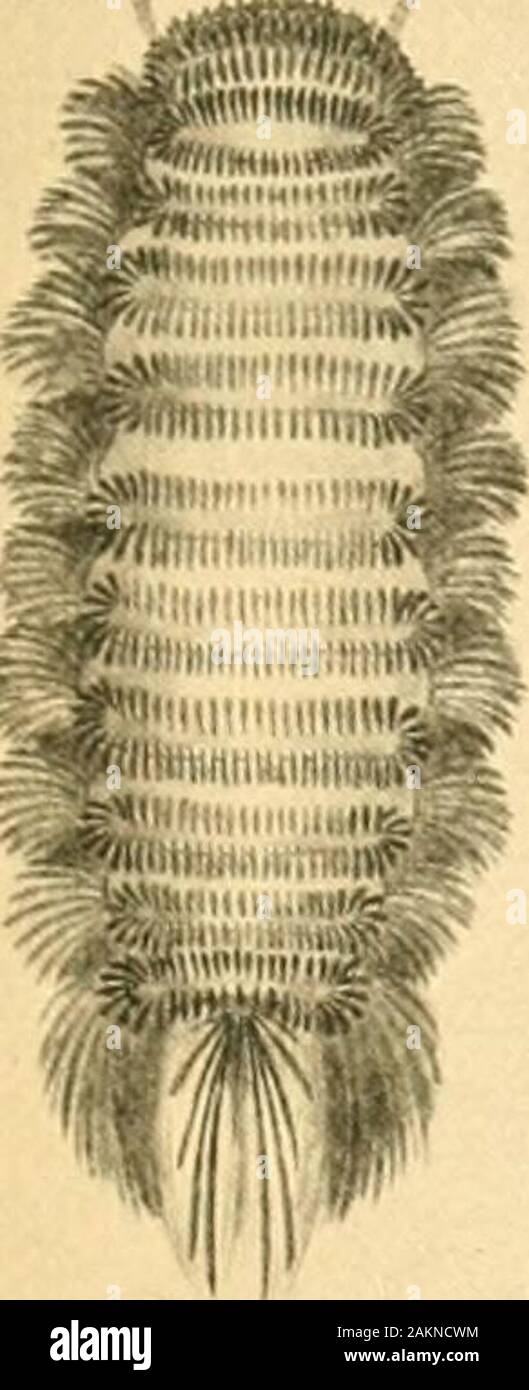Guide to the Crustacea, Arachnida, Onychophora and Myriopoda exhibited in the Department of Zoology, British Museum (Natural History) .. . are two sub-classes. Sub-class I. PSELAPHOGNATHA. The meml)ers of this sub-class arc small, soft-bodied forms, inwhich the body is composed of eleven segments and bearsthirteen pairs of legs. The upper surface of the head and body-segments is furnished with a number of flattened scale-like hairs. Diplopoda. Vl No. 27. and large tufts of similar hairs project from the sides of each Table-casesegment; the last segment is fm^nished with a tuft of long hairs.T

Image details
Contributor:
The Reading Room / Alamy Stock PhotoImage ID:
2AKNCWMFile size:
7.1 MB (237.7 KB Compressed download)Releases:
Model - no | Property - noDo I need a release?Dimensions:
1009 x 2475 px | 17.1 x 41.9 cm | 6.7 x 16.5 inches | 150dpiMore information:
This image is a public domain image, which means either that copyright has expired in the image or the copyright holder has waived their copyright. Alamy charges you a fee for access to the high resolution copy of the image.
This image could have imperfections as it’s either historical or reportage.
Guide to the Crustacea, Arachnida, Onychophora and Myriopoda exhibited in the Department of Zoology, British Museum (Natural History) .. . are two sub-classes. Sub-class I. PSELAPHOGNATHA. The meml)ers of this sub-class arc small, soft-bodied forms, inwhich the body is composed of eleven segments and bearsthirteen pairs of legs. The upper surface of the head and body-segments is furnished with a number of flattened scale-like hairs. Diplopoda. Vl No. 27. and large tufts of similar hairs project from the sides of each Table-casesegment; the last segment is fm^nished with a tuft of long hairs.The mouth-parts consist of paired mandibles, maxillulae and maxillae and a labium. These curious little millipedes are widelydistributed, and live beneath stones orthe bark of trees. There is a singlefamily, Polyxenidac, with two genera; onespecies (PoJyxcnns l((ijnrus) occurs in thiscountry. Sub-class II.—CHILOGNATHA. Tlie body of the Chilognatha is hard andstrongly chitinized, and is not furnishedwith tufts of scale-like hairs. The maxillaeusually fuse to form a complicated gnatho-chilarium. There are three orders of Chilognatha.. Fig. 82. Polyxenus lagiirus, theEnglish bristly milli-pede, X 12. Order 1. Oniscomorpha. The body is short and stout in the Oniscomorpha, and thei-eare eleven, twelve or thirteen dorsal plates, the last of them beingof large size. The copulatory feet of the male are situated on thepenultimate segment. The tracheal tulles are branched, and thereare no stink-glands. In general appearancethe smaller species resembleclosely the wood-lice, which belong to the widelydifferent group of the Crus-tacea Isopoda (see p. 43), and, like them, are able toroll themselves into a ball.They are widely distributed, but are very rare in America.The typical dark variety of(rloiiieris vianjinata, the Pill-Millipede, occurs in Great Britain and Ireland. h SouthernEurope a large number of sul)-species and varieties of Glomcris ^^mm T Fig. 83. Sphacrotheriumininctatnm (slight